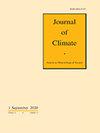Uncertainties in the projection of dynamic sea level in CMIP6 and FGOALS-g3 large ensemble
IF 4
2区 地球科学
Q1 METEOROLOGY & ATMOSPHERIC SCIENCES
引用次数: 0
Abstract
Abstract Decision-makers need reliable projections of future sea level change for risk assessment. Untangling the sources of uncertainty in sea level projections will help narrow the projection uncertainty. Here, we separate and quantify the contributions of internal variability, intermodel uncertainty, and scenario uncertainty to the ensemble spread of dynamic sea level (DSL) at both the basin and regional scales using Coupled Model Intercomparison Project Phase 6 (CMIP6) and FGOALS-g3 large ensemble (LEN) data. For basin-mean DSL projections, intermodel uncertainty is the dominant contributor (>55%) in the near- (2021-2040), mid- (2041-2060), and long-term (2081-2100) relative to the climatology of 1995-2014. Internal variability is of secondary importance in the near- and mid-term until scenario uncertainty exceeds it in all basin except the Indian Ocean in the long-term. For regional-scale DSL projections, internal variability is the dominant contributor (60~100%) in the Pacific Ocean, Indian Ocean and western boundary of the Atlantic Ocean, while intermodel uncertainty is more important in other regions in the near-term. The contribution of internal variability (intermodel uncertainty) decreases (increases) in most regions from mid-term to long-term. Scenario uncertainty becomes important after emerging in the Southern, Pacific, and Atlantic oceans. The signal-to-noise (S/N) ratio maps for regional DSL projections show that anthropogenic DSL signals can only emerge from a few regions. Assuming that model differences are eliminated, the perfect CMIP6 ensemble can capture more anthropogenic regional DSL signals in advance. These findings will help establish future constraints on DSL projections and further improve the next generation of climate models.CMIP6 和 FGOALS-g3 大集合中动态海平面预测的不确定性
摘要 决策者需要可靠的未来海平面变化预测来进行风险评估。理清海平面预测的不确定性来源将有助于缩小预测的不确定性。在此,我们利用耦合模式相互比较项目第 6 阶段(CMIP6)和 FGOALS-g3 大集合(LEN)数据,在流域和区域尺度上分离并量化了内部变率、模式间不确定性和情景不确定性对动态海平面(DSL)集合传播的贡献。对于流域平均 DSL 预测,相对于 1995-2014 年的气候学,在近期(2021-2040 年)、中期(2041-2060 年)和长期(2081-2100 年),模式间不确定性是主要因素(>55%)。内部变率在近期和中期是次要的,直到长期除印度洋以外的所有海盆的情景不确定性超过内部变率。对于区域尺度的 DSL 预测,内部变率是太平洋、印度洋和大西洋西部边界的主要影响因素(60%~100%),而模型间不确定性在近期对其他区域更为重要。从中期到长期,内部变率(模式间不确定性)的贡献在大多数地区都会减小(增大)。情景不确定性在南大洋、太平洋和大西洋出现后变得非常重要。区域 DSL 预测的信噪比(S/N)图显示,人为 DSL 信号只能从少数区域出现。假设消除了模型差异,完美的 CMIP6 组合可以提前捕捉到更多的人为区域 DSL 信号。这些发现将有助于建立未来对DSL预测的约束条件,并进一步改进下一代气候模式。
本文章由计算机程序翻译,如有差异,请以英文原文为准。
求助全文
约1分钟内获得全文
求助全文
来源期刊

Journal of Climate
地学-气象与大气科学
CiteScore
9.30
自引率
14.30%
发文量
490
审稿时长
7.5 months
期刊介绍:
The Journal of Climate (JCLI) (ISSN: 0894-8755; eISSN: 1520-0442) publishes research that advances basic understanding of the dynamics and physics of the climate system on large spatial scales, including variability of the atmosphere, oceans, land surface, and cryosphere; past, present, and projected future changes in the climate system; and climate simulation and prediction.
 求助内容:
求助内容: 应助结果提醒方式:
应助结果提醒方式:


